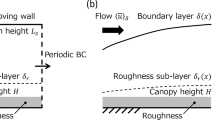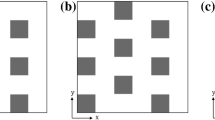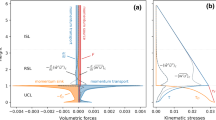Abstract
Momentum and heat transfer was examined for the urban-like surfaces used within the Comprehensive Outdoor Scale MOdel (COSMO) experiments. Simultaneous and comparative meteorological measurements were made over a pair of scale models with different block geometries. These data were analyzed to investigate the influence of height variations, obstacle elongation, and packing density, λ p , of blocks on the aerodynamic properties. In addition, the robustness of theoretical expressions of bulk transfer coefficients for momentum and heat with respect to geometric parameters was examined. Our analyses showed: (1) the theoretical framework for the bulk transfer coefficient for momentum, C m , and that for heat, C h , was applicable for homogeneous building arrays, (2) the sensitivity of C h to the surface geometry was smaller than that of C m , (3) the transfer coefficients were increased by variations of block heights, but not by elongation of blocks, (4) first-order approximations of C m and C h for an array of blocks with two different heights can be made by applying simple theoretical assumptions to include the effects of height variation, and (5) variations of block heights increased the momentum flux significantly, but caused little change in the sensible heat flux. This can be explained by the feedback mechanism of aerodynamic– thermal interaction; aerodynamic mixing decreased both the advective velocity and the vertical temperature gradient.
Similar content being viewed by others
References
Barlow JF, Belcher SE (2002) A wind tunnel model for quantifying fluxes in the urban boundary layer. Boundary-Layer Meteorol 104: 131–150. doi:10.1023/A:1015555613672
Brutsaert W (1982) Evaporation into the atmosphere. D. Reidel Publishing Company, Holland, p 299 pp
Cheng H, Castro IP (2002) Near wall flow over urban-like roughness. Boundary-Layer Meteorol 104: 229–259. doi:10.1023/A:1016060103448
Christen A, Vogt R (2004) Energy and radiation balance of a central European city. Int J Climatol 24: 1395–1421
Clarke JF, Ching JKS, Godowitch JM (1982) An experimental study of turbulence in an urban environment. Tech. Rep. U.S. E.P.A. Research Triangle Park, N.C. NMS PB 226085
Coceal O, Thomas TG, Castro IP, Belcher SE (2006) Mean flow and turbulence statistics over groups of urban-like cubical obstacles. Boundary-Layer Meteorol 121: 491–519. doi:10.1007/s10546-006-9076-2
Coutts AM, Beringer J, Tapper NJ (2007) Impact of increasing urban density on local climate: spatial and temporal variations in the surface energy balance in Melbourne, Australia. J Appl Meteorol Climatol 46: 477–493. doi:10.1175/JAM2462.1
Cui J, Patel VC, Lin CL (2003) Large-eddy simulation of turbulent flow in a channel with rib roughness. Int J Heat Fluid Flow 24: 372–388. doi:10.1016/S0142-727X(03)00002-X
Hagishima A, Tanimoto J, Nagayama K, Koga M (2007) Wind tunnel experiment on drag force coefficient of regular arrayed rectangular blocks with different heights. J Environ Eng 619:39–45. (in Japanese, Transactions of AIJ)
Hogstrom U (1990) Analysis of turbulence structure in the surface layer with a modified similarity formulation for near neutral conditions. J Atmos Sci 47: 1949–1972. doi:10.1175/1520-0469(1990)047<1949:AOTSIT>2.0.CO;2
Inagaki A, Kanda M (2008) Turbulent flow similarity over an outdoor reduced urban model. J Fluid Mech 615: 101–120. doi:10.1017/S0022112008003765
Kanda M (2006) Large eddy simulations on the effects of surface geometry of building arrays on turbulent organized structures. Boundary-Layer Meteorol 118: 151–168. doi:10.1007/s10546-005-5294-2
Kanda M, Kanega M, Kawai T, Moriwaki R, Sugawara H (2007) Roughness lengths for momentum and heat derived from outdoor urban scale models. J Appl Meteorol Climatol 46: 1067–1079. doi:10.1175/JAM2500.1
Kawai T, Kanda M (2009) Energy balance obtained from comprehensive outdoor urban scale model experiment (II) Comparison with field data using new energy indices. J Appl Meteorol Climatol (submitted)
Kawai T, Mohammad KR, Kanda M (2009) Evaluation of a simple urban energy balance model using one-year observed fluxes from two different cities. J Appl Meteorol Climatol. doi:10.1175/2008JAMC1891.1
Macdonald RW, Hall DJ, Walker S, Spanton AM (1998a) Wind tunnel measurements of windspeed within simulated urban arrays. BRE Client Report CR 243/98, 62 pp
Macdonald RW, Griffiths RF, Hall DJ (1998b) An improved method for the estimation of surface roughness of obstacle arrays. Atmos Environ 32: 1857–1864. doi:10.1016/S1352-2310(97)00403-2
Moriwaki R, Kanda M (2006) Scalar roughness parameters for a suburban area. J Meteorol Soc Jpn 84: 1065–1073. doi:10.2151/jmsj.84.1063
Narita K (2007) Experimental study of the transfer velocity for urban surfaces with a water evaporation method. Boundary-Layer Meteorol 122: 293–320. doi:10.1007/s10546-006-9116-y
Oke TR (1987) Boundary layer climates. Routledge, London, p 435 pp
Pascheke F, Barlow JF, Robins A (2008) Wind-tunnel modelling of dispersion from a scalar area source in urban-like roughness. Boundary-Layer Meteorol 126: 103–124. doi:10.1007/s10546-007-9222-5
Paulson CA (1970) The mathematical representation of wind speed and temperature profiles in the unstable atmospheric surface layer. J Appl Meteorol 9: 857–861. doi:10.1175/1520-0450(1970)009<0857:TMROWS>2.0.CO;2
Roth M (2000) Review of atmospheric turbulence over cities. Q J Roy Meteorol Soc 126: 941–990. doi:10.1256/smsqj.56408
Sugawara H (2001) Heat exchange between urban structures and the atmospheric boundary layer. Doctoral dissertation, National Defense Academy of Japan, 140 pp
Voogt JA, Grimmond CSB (2000) Modeling surface sensible heat flux using surface radiative temperatures in a simple urban area. J Appl Meteorol 39: 1679–1699
Xie ZT, Coceal O, Castro IP (2008) Large-eddy simulation of flows over random urban-like obstacles Boundary-Layer Meteorol 129:1–23. doi:10.1007/s10546-008-9290-1
Author information
Authors and Affiliations
Corresponding author
Rights and permissions
About this article
Cite this article
Kanda, M., Moriizumi, T. Momentum and Heat Transfer over Urban-like Surfaces. Boundary-Layer Meteorol 131, 385–401 (2009). https://doi.org/10.1007/s10546-009-9381-7
Received:
Accepted:
Published:
Issue Date:
DOI: https://doi.org/10.1007/s10546-009-9381-7




